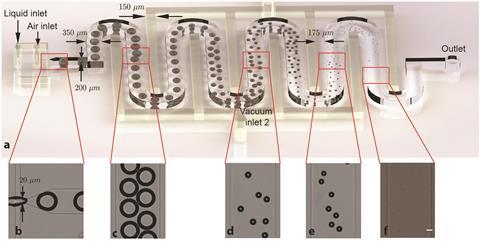Shrinking the microbubbles needed for ultrasound with microfluidics

Researchers in Canada have shrunk bubbles to single-micrometre diameters, suitable for use in ultrasound.
Microbubbles are commonly used in ultrasound imaging as they improve the visual distinction between blood and surrounding tissues. Bubbles are injected intravenously, and under ultrasound they are excited at their resonant frequency. This resonance means they scatter a much higher proportion of the ultrasound than the surrounding tissues, allowing clear imaging of blood vessels.
The bubbles needed for ultrasound are around 2µm in diameter. Current microfluidic techniques cannot produce bubbles this small, and the techniques used to generate these microbubbles generally use physical agitation or shearing. The bubbles produced often have a large size distribution, and filtration is needed to separate out those suitable for use.
Now Scott Tsai and coworkers at Ryerson University in Canada think they’ve found a solution. They’ve developed a microfluidic system with vacuum microchannels next to the main serpentine channel. The system initially generates microbubbles larger than 100 µm in diameter, and then they tune the vacuum pressure in the adjacent chamber to shrink these bubbles down to 1–7µm. The generated bubbles are stable and uniform in size, ideal for use in ultrasound without the need for further filtration.
Tsai explains that one limitation of the system is the ability to generate sufficient bubbles for clinical application – currently their system would take up to three years to produce enough bubbles for a procedure. However, they are now engineering scale-up solutions to this problem. ‘Our goal is to have a system that generates sufficient microbubbles for an ultrasound operation in just an hour or so,’ says Tsai.
Eleanor Stride, an expert in biomedical ultrasonics at the University of Oxford in the UK, praised the work. ‘It’s a very elegant idea to solve one of the challenges associated with using microfluidics for bubble fabrication,’ she says. Steve Shih, a microfluidics expert at Concordia University in Canada likes the simplicity of the system: ‘What I love about it is that anyone can make these devices without any sort of specialized knowledge or background.’
Aside from ultrasound, there are other potential applications for these microbubbles. ‘[They] are being investigated in applications such as wastewater treatment, cleaning and disinfection of surfaces, and eradication of biofilms,’ explains Raffi Karshafian, who also worked on the project. ‘The effectiveness of these applications may potentially be improved through the utilization of monodisperse small bubbles’.
References
This article is free to access until 24 May
V Gnyawali et al, Soft Matter, 2017, DOI: 10.1039/C7SM00128B












No comments yet